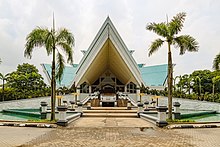
Kuala Lumpur, officially the Federal Territory of Kuala Lumpur and colloquially referred to as KL, is a federal territory and the capital city of Malaysia. It is the largest city in the country, covering an area of 243 km2 (94 sq mi) with a census population of 2,075,600 as of 2024. Greater Kuala Lumpur, also known as the Klang Valley, is an urban agglomeration of 8.8 million people as of 2024. It is among the fastest growing metropolitan regions in Southeast Asia, both in population and economic development.
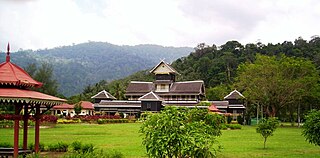
Seri Menanti is a town, a mukim, and a state assembly constituency in Kuala Pilah District, central Negeri Sembilan, Malaysia, located 33 km east of the state capital city of Seremban and 14 km southwest of Kuala Pilah. It is the royal capital of the state of Negeri Sembilan and houses the seat of the ruler of the state of Negeri Sembilan, referred to as the Yang Di-Pertuan Besar of Negeri Sembilan or Yamtuan Besar. The royal palace is known as Istana Besar.

Hang Tuah, according to the semi-historical Malay Annals, was a warrior and Laksamana who lived in Malacca during the reign of Sultan Mansur Shah in the 15th century. However, there is limited historical evidence for his existence. He was supposedly a great laksamana, or admiral, a diplomat and a silat master. Hang Tuah is the most illustrious warrior figure in Malay literature. He is however, a somewhat controversial figure and there is much in dispute about the factual basis of Hang Tuah's story.
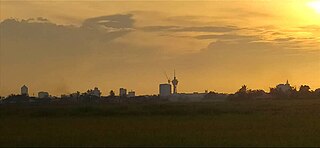
Alor Setar is the state capital of Kedah, Malaysia. It is the second-largest city in the state after Sungai Petani and one of the most-important cities on the west coast of Peninsular Malaysia. It is home to the third-tallest tower in Malaysia, the Alor Setar Tower.

Bangsawan is a type of traditional Malay opera or theatre performed by a troupe and accompanied by music and sometimes dances. The bangsawan theatrical performance encompasses music, dance, and drama. It is widely spread in the Malay cultural realm in Malaysia, Indonesia, Singapore, and Brunei. The artform is indigenous to the Malay Peninsula, Riau Islands, Sumatra, and coastal Borneo.
Puan Sri Tiara Jacquelina Eu Effendi is a Malaysian actress, film producer, musical theater producer, singer, and the founder of The Enfiniti Academy of Musical Theatre and Performing Arts. She is well-acclaimed for her role in Puteri Gunung Ledang, the biggest budget movie ever produced in Malaysia up until 2005, in which she played the lead character and sang the theme song, "Asmaradana". Aside from appearing on stage and on camera, Tiara Jacquelina also serves as the managing director of Enfiniti Vision Media, a Malaysian arts, entertainment, and television production company.

The National Museum is a public museum in Kuala Lumpur, Malaysia dedicated to Malaysian art, culture, and history. Located on Jalan Damansara close to Perdana Lake Gardens across KL Sentral station. Its façade comprises elements from both traditional Malay and modern features. It was inaugurated on 31 August 1963, and it serves as a repository of Malaysia's cultural and historical heritage.

Malay houses refer to the vernacular dwellings of the Malays, an ethno-linguistic group inhabiting Sumatra, coastal Borneo and the Malay Peninsula.

Taman Mini Indonesia Indah is a culture-based recreational area located in East Jakarta, Indonesia. Since July 2021, it is operated by PT Taman Wisata Candi Borobudur, Prambanan, dan Ratu Boko, a subsidiary of the state-owned tourism holding company Injourney. It was operated by Yayasan Harapan Kita, a foundation established by Siti Hartinah, the first lady during most of the New Order and wife of Suharto, and run by Suharto's descendants since his death until 2021. It has an area of about 147 hectares. The project cost some US$ 26 million.
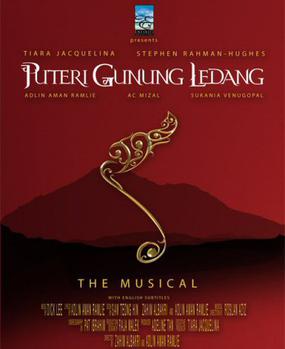
Puteri Gunung Ledang is a Malaysian musical directed by Zahim Albakri, co-directed by Adlin Aman Ramlie, book by Adlin Aman Ramlie, Saw Teong Hin and Zahim Al-Bakri and music composed by Dick Lee. The musical is based on the 2004 Puteri Gunung Ledang film. The original production was staged at the Istana Budaya in February 2006, this was followed by two more productions and an upcoming third in February 2009. Tiara Jacquelina and Stephen Rahman-Hughes starred as Gusti Putri and Hang Tuah in all the productions to date. Other members of the production team are music director Roslan Aziz, choreographer Pat Ibrahim and production designer Raja Malek. The musical was staged in poetic Malay and Javanese-accented Malay, but English subtitles were provided.

The Tangkak District is a district in western Johor, Malaysia, bordering Muar District to the south, Segamat District to the northeast, and Jasin District, Malacca to the west. The district also shares an 11 kilometre border with Tampin District, Negeri Sembilan to the northwest. The district capital and largest settlement is the town of Tangkak. Other towns include Sagil, Sungai Mati and Tanjung Agas.

The Petronas Philharmonic Hall is Malaysia's first concert hall built specifically for classical music. It is the home of the Malaysian Philharmonic Orchestra (MPO), and has hosted many of the world's leading orchestras such as New York Philharmonic, Philadelphia Orchestra, BBC Symphony and Vienna Symphony.
The architecture of Kuala Lumpur is a blend of old colonial influences, Asian traditions, Malay Islamic inspirations, modern and post modern mix. Being a relatively young city, most of Kuala Lumpur's colonial buildings were built toward the end of 19th and early 20th century. These buildings have Mughal, Tudor, Neo-Gothic or Grecian-Spanish style or architecture. Most of the styling have been modified to cater to use local resources and the acclimatized to the local climate, which is hot and humid all year around.

The National Art Gallery of Malaysia is a public art gallery in Kuala Lumpur, Malaysia.

Abdul Muid bin Abdul Latif was a Malaysian-based web designer, graphic designer and digital artist, who is known for promoting the cultural elements of the Southeast Asia from Batik and Songket into his commercial works and artworks.

The Istana Negara is the official residence of the Yang di-Pertuan Agong. It is located along Jalan Tuanku Abdul Halim near Taman Duta, northwestern Kuala Lumpur. The palace opened in 2011 and replaced the old Istana Negara which was located at a different compound in central Kuala Lumpur.
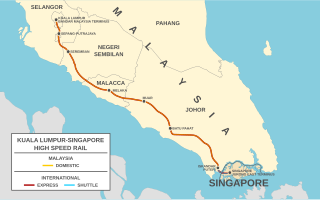
The Kuala Lumpur–Singapore high-speed rail (HSR) is a proposed railway project to link Kuala Lumpur, Malaysia to Singapore via a high-speed rail line. It was first proposed by then Malaysian Prime Minister Najib Razak in September 2010. Singapore’s former Prime Minister Lee Hsien Loong formally agreed to the joint project in February 2013, with the HSR originally expected to be completed by the year of 2026.

The Istana Satu was a royal residence in Kuala Terengganu in Malaysia.
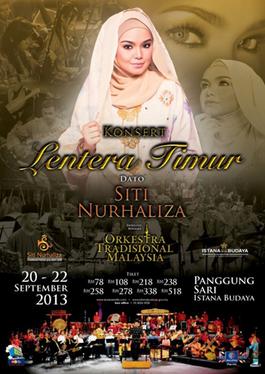
Konsert Lentera Timur was a concert residency by Malaysian recording artist, Siti Nurhaliza. Held on four non consecutive nights in September 2013 at Istana Budaya, this was her first concert in which the songs performed were mainly driven by traditional Malay and folk music genres. Many of the songs were taken or derived from her four solo traditional albums: Cindai (1997), Sahmura (2000), Sanggar Mustika (2002) and Lentera Timur (2008). During the course of the four-night concert, she performed more than 30 songs and was backed by 40-piece traditional Malaysian orchestra, Orkestra Traditional Malaysia (OTM). The musical backing included an amalgamation of sounds from different traditional musical instruments, including strings and percussion that are synonymous with Malaysia's multiracial culture – Rebana, Er-hu, Sitar and Sapeh.
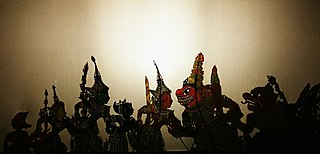
Malaysian folklore is the folk culture of Malaysia and other indigenous people of the Malay Archipelago as expressed in its oral traditions, written manuscripts and local wisdoms. Malaysian folklores were traditionally transmitted orally in the absence of writing systems. Oral tradition thrived among the Malays, but continues to survive among Orang Asli and numerous Bornean ethnic groups in Sarawak and Sabah. Nevertheless, Malaysian folklores are closely connected with classical Malay folklore of the region. Even though, Malay folklore tends to have a regional background, with the passing of time, and through the influence of the modern media, large parts of regional Malay folklore have become interwoven with the wider popular Malaysian folklore.


